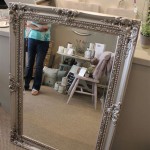Mirror Tile Wall
Mirror tiles offer a versatile and impactful design element for various spaces. Their reflective properties can enhance natural light, create an illusion of spaciousness, and add a touch of glamour. This article explores the practical applications, design considerations, and installation process of mirror tile walls.
Types of Mirror Tiles
Several types of mirror tiles cater to different aesthetic preferences and practical needs. Understanding the distinctions aids in selecting the appropriate tile for a specific project.
- Glass Mirror Tiles: These are the most common type, offering a classic, reflective surface. They come in various sizes, thicknesses, and edge treatments.
- Acrylic Mirror Tiles: A lightweight and shatter-resistant alternative to glass, acrylic tiles are suitable for high-traffic areas or spaces where safety is a concern.
- Self-Adhesive Mirror Tiles: These tiles simplify installation with a peel-and-stick backing, making them ideal for DIY projects.
- Antique Mirror Tiles: These offer a vintage aesthetic with a distressed or aged appearance, adding character and depth to a space.
Applications of Mirror Tile Walls
Mirror tile walls can transform various spaces, serving both functional and aesthetic purposes.
- Small Rooms: Strategically placed mirror tiles can visually expand smaller rooms, creating an illusion of greater depth and spaciousness.
- Dark Rooms: Mirrors reflect natural light, brightening dimly lit areas and reducing the need for artificial lighting.
- Accent Walls: A mirror tile wall can serve as a striking focal point, adding a touch of glamour and sophistication to a room.
- Backsplashes: In kitchens and bathrooms, mirror tiles can create a stylish and easy-to-clean backsplash.
- Decorative Features: Mirror tiles can be incorporated into furniture, decorative panels, or art pieces, adding a reflective element to various design schemes.
Design Considerations for Mirror Tile Walls
Careful planning ensures the successful integration of mirror tiles into a design scheme.
- Tile Size and Shape: Larger tiles create a seamless, modern look, while smaller tiles offer a more intricate and traditional feel. Various shapes, such as squares, rectangles, and hexagons, provide design flexibility.
- Grouting: Grout lines can impact the overall aesthetic. Thin grout lines create a more unified appearance, while thicker grout lines emphasize individual tiles.
- Lighting: Consider the placement of light fixtures to maximize the reflective properties of the mirror tiles and avoid unwanted glare.
- Surrounding Decor: The surrounding decor should complement the mirror tile wall without creating visual clutter or competing for attention.
Preparing the Surface for Installation
Proper surface preparation is crucial for achieving a professional and long-lasting mirror tile installation.
- Clean Surface: The wall must be clean, dry, and free of dust, grease, and debris. Clean the surface thoroughly with a suitable cleaning solution.
- Smooth Surface: Any imperfections or unevenness in the wall should be addressed. Fill holes and cracks with spackling compound and sand smooth.
- Prime the Surface: Applying a primer ensures better adhesion of the adhesive or mortar used for installation.
Installation Methods for Mirror Tiles
Several methods exist for installing mirror tiles, each with its own advantages and disadvantages.
- Adhesive: Self-adhesive tiles are easy to install, but may not be suitable for all surfaces. Specialized mirror adhesives offer stronger bonding.
- Thin-Set Mortar: This method provides a more secure and permanent installation, especially for larger or heavier tiles.
- Mirror Mastic: This specialized adhesive is designed for bonding mirrors to various surfaces, offering a strong and durable hold.
Maintenance and Cleaning of Mirror Tile Walls
Regular maintenance ensures the longevity and aesthetic appeal of mirror tile walls.
- Regular Cleaning: Clean the tiles regularly with a glass cleaner and a soft cloth to remove dust, fingerprints, and smudges.
- Avoid Abrasive Cleaners: Harsh chemicals and abrasive cleaners can damage the reflective surface of the mirror tiles.
- Inspect Grout: Regularly inspect the grout for any signs of cracking or discoloration and address any issues promptly.
Safety Precautions During Installation
Safety should always be a priority during any installation project.
- Eye Protection: Wear safety glasses to protect eyes from dust and debris during surface preparation and installation.
- Gloves: Wear gloves to protect hands from adhesives and sharp edges of the tiles.
- Ventilation: Ensure adequate ventilation when working with adhesives or primers.
Mirror tiles provide a dynamic and versatile design element, offering a range of applications and aesthetic possibilities. Careful consideration of tile type, installation methods, and maintenance practices ensures a successful and long-lasting mirror tile installation.

Mirrored Diamond Wall Tiles Pack

Mirror Walls And Tiles Mirrorworld

Mirrored Tiles Mirrorworld

Mirrored Walls And Wall Tiles Pinesway Glass Ltd

Antique Mirrored Wallpaper Mad About The House

How To Use Decorative Mirror Tiles In Interior Design

Antique Mirror Tiles Glass
Antique Mirror Tile Retro Reflections

Abolos Reflections Silver Beveled Square 8 In X Glass Mirror Wall L And Stick Tile 4 Sq Ft Case Ghmref0808 Si The Home Depot

Rectangular Mirror Tiles Wall Decor Living Room








